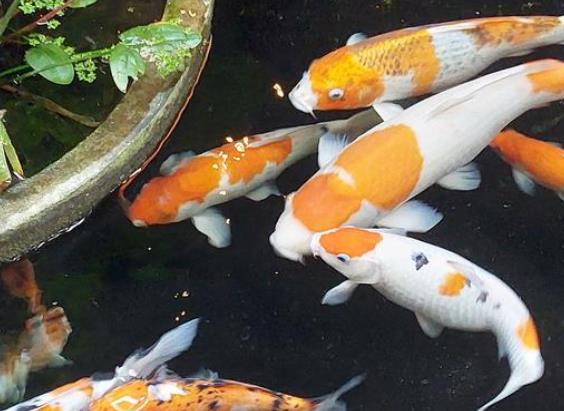Here is a systematic sorting of the classification and characteristics of different koi varieties, combing body color characteristics, cultural implications, and market values:

I. Classic Varieties
Kohaku (Red and White Koi)
Features: Pure white base with bright red patterns. The red spots on the head do not cross the eyes, and a red plate finishes at the tail stalk.
Status: Hailed as the "orthodox koi," symbolizing purity and auspiciousness.
Subtypes: Two-step Kohaku, Three-step Kohaku, and Lightning Kohaku (red patterns distributed like lightning).
Taisho Sanshoku Koi
Features: Interwoven red and black patterns on a white base, no black spots on the head, and black stripes on the pectoral fins.
Appreciation Key Points: Ink as dark as lacquer, vivid red patterns, and a pure white base.
Derivative Varieties: Lipstick Sanshoku (red spot on the mouth), Akam Sanshoku (dominated by red).
Showa Sanshoku Koi
Features: Predominantly black base covered with red and white patterns, often with black spots on the head and dense ink at the base of the pectoral fins.
Difference: Compared with Taisho Sanshoku, Showa has thicker ink and more dynamic patterns.
Variants: Hi Showa (expanded red patterns), Tancho Showa (single red spot on the head).
II. Distinctive Varieties
Tancho Koi
Features: All-white body with a single round red spot on the head, swimming elegantly like a "white dragon crossing the river."
Meaning: In feng shui, it is called "good luck at the top," symbolizing official career prosperity.
Kin Gin Rin (Metallic Scale Koi)
Features: Scales with metallic luster. A red base with gold scales is called "Kin Rin," and a white base with silver scales is called "Gin Rin."
Hybrids: Kin Gin Rin Kohaku, Kin Gin Rin Showa, etc. The reflectivity of the scales determines the value.
Aka Utsuri (Autumn Emerald Koi)
Features: Cobalt blue back, bright red patterns on the abdomen, and lateral line scales tightly arranged like an autumn sky.
German Variant: With mirror carp lineage, fewer or no scales, and more transparent body color.
Iron-Wrapped Gold Koi
Special Body Color: All-black body with a golden sheen on the abdomen, requiring 4-6 hours of direct sunlight daily to maintain the color.
Market Value: Excellent specimens can reach tens of thousands of yuan, but professional breeding techniques are needed.
III. Culturally Symbolic Varieties
Dragon and Phoenix Koi
Features: Elongated barbels like dragon whiskers, wide tail fins like phoenix tails, and elegant swimming posture.
Meaning: "Dragon and Phoenix bringing prosperity," commonly seen in feng shui landscapes.
Kumonryu (Nine-Stripe Dragon Koi)
Features: Black patterns on a white base like ink wash painting, with patterns changing with seasons, embodying Oriental artistic conception.
Name Origin: Patterns resemble a dragon swimming 潜.
Matsuba (Pine Needle Koi)
Features: Scale patterns like pine needles, simple and tenacious, divided into Akamatsuba (red base with black patterns) and Shiro Matsuba.
Symbolism: Longevity and unyielding spirit.
IV. Rare and Hybrid Varieties
Gin Rin Koi
Features: Hybrids of Kohaku or Sanshoku and Asagi, with red patterns edged in blue mesh (such as Blue Gin Rin).
Variants: Moku Gin (red patterns covered with ink spots), Grape Sanshoku (patterns clustered like grapes).
Butterfly Koi
Features: Elongated fins like butterfly wings, predominantly platinum in color, suitable for mixing with other ornamental fish.
V. Variety Selection Suggestions
For Beginners: Kohaku, Taisho Sanshoku (easy to raise, high ornamental value).
For Advanced Keepers: Showa Sanshoku, Tancho (need to focus on water quality and bloodline).
For Special Needs: Iron-Wrapped Gold, Kin Gin Rin (need professional maintenance skills).
Different koi varieties can breed new variants through crossbreeding. When purchasing, it is recommended to pay attention to uniform body color, symmetrical patterns, and steady swimming posture.
